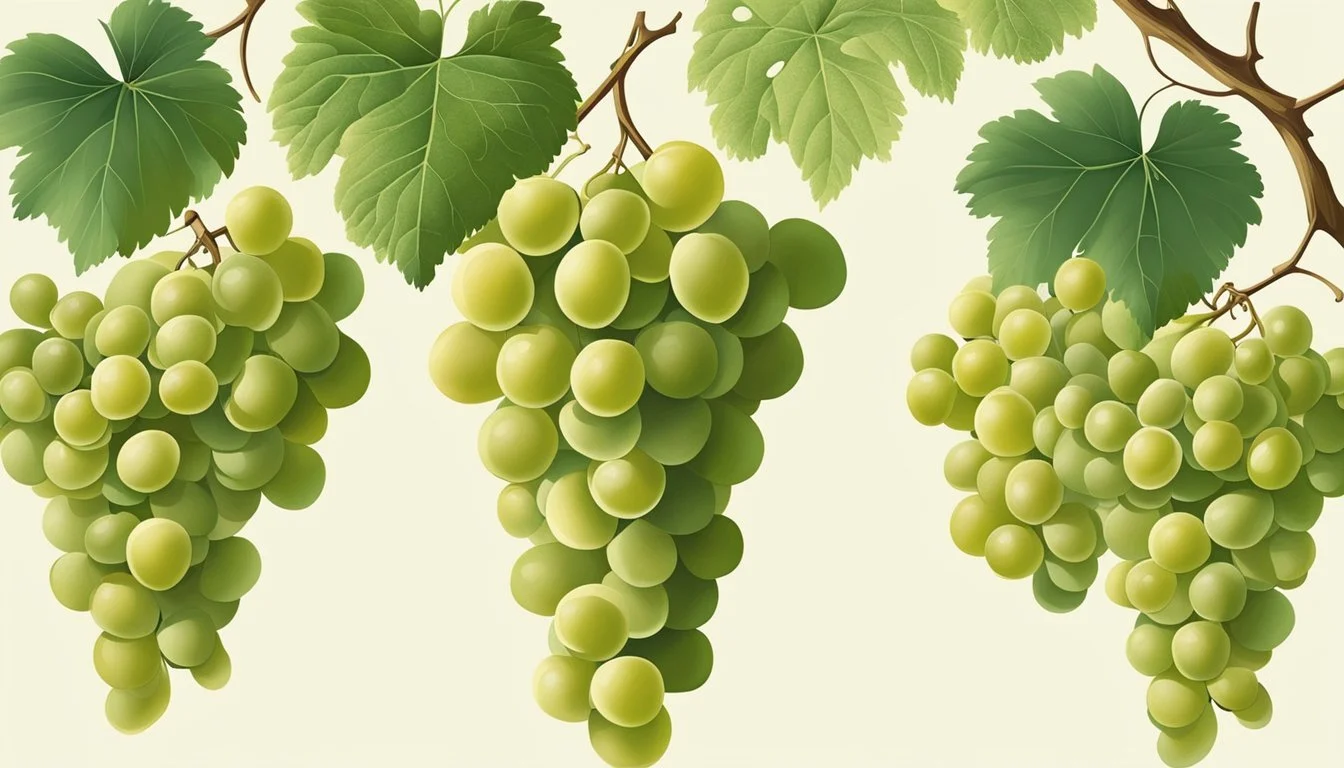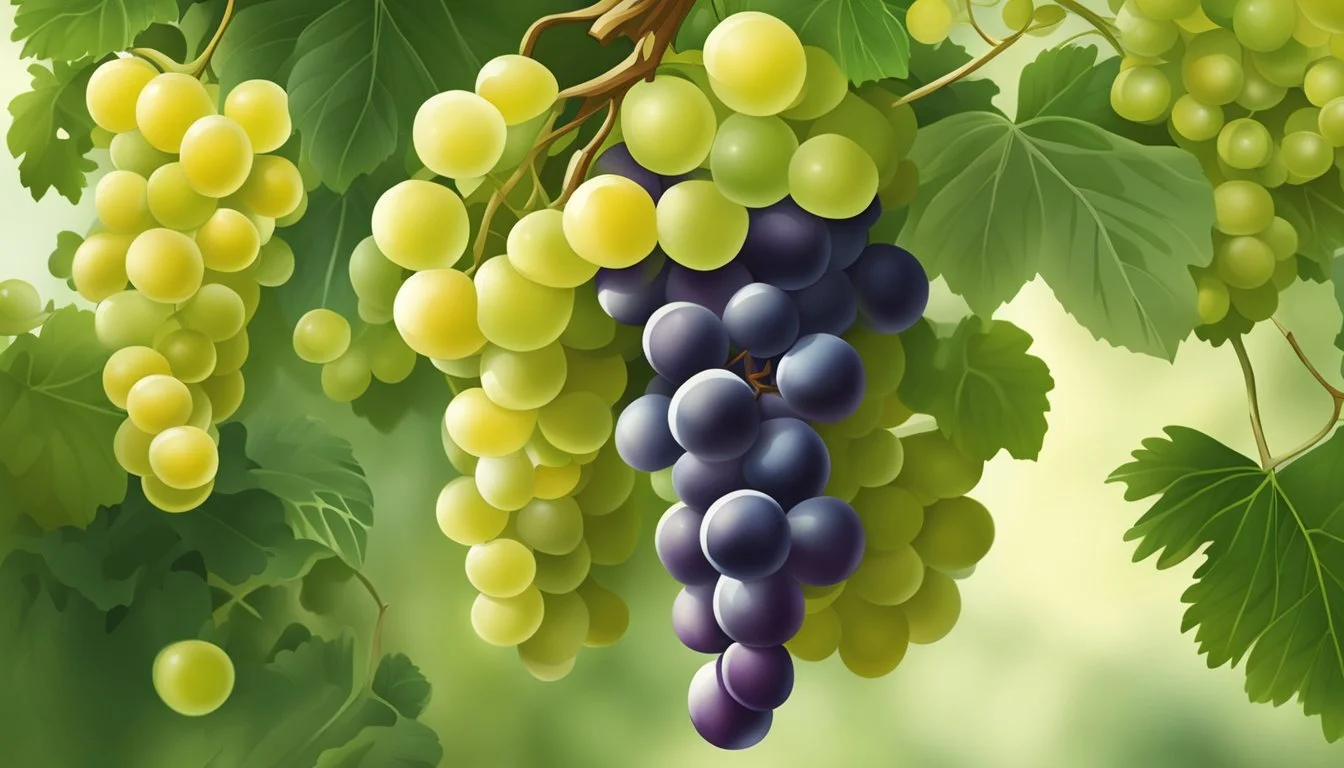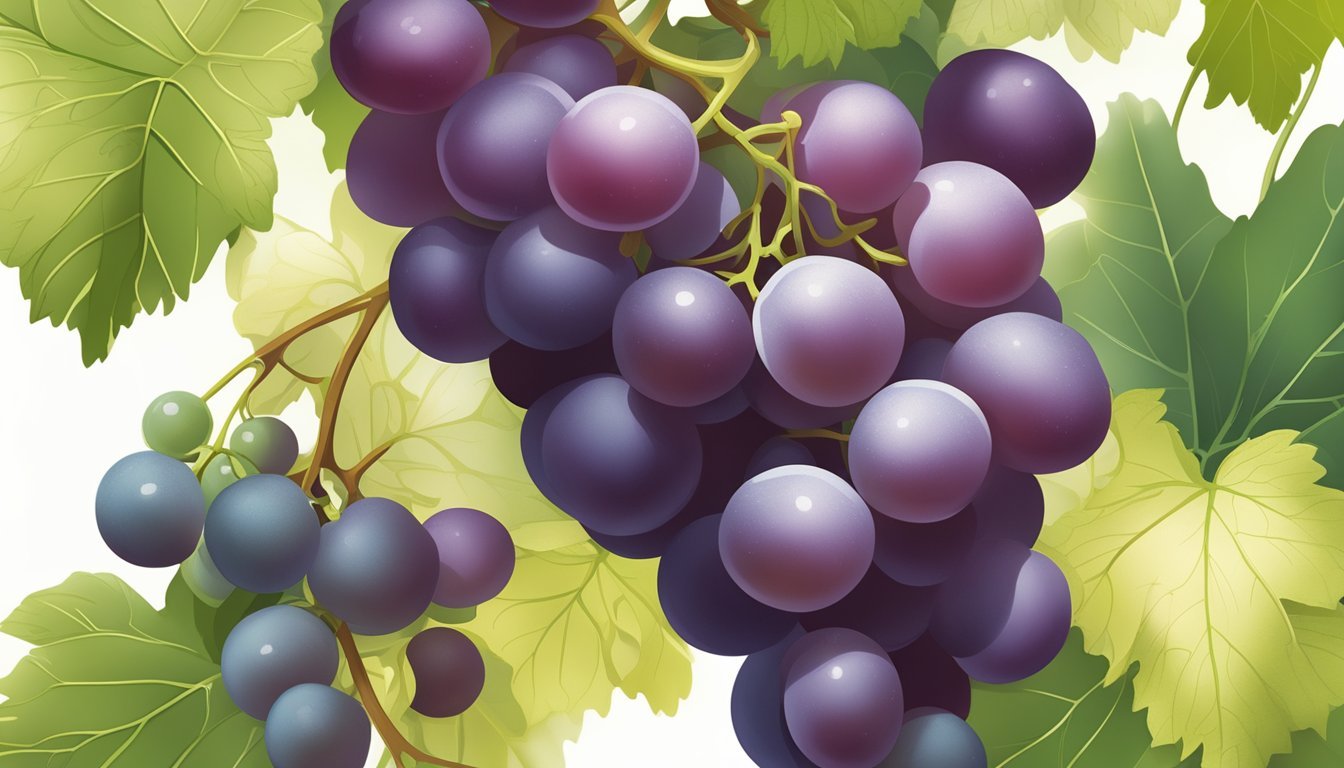How to Tell If Thompson Seedless Grapes Are Ripe
Expert Tips for Perfect Picking
Thompson Seedless grapes, known for their versatility and popularity as a table grape, are a common sight in gardens and on dining tables. Understanding when these grapes are ripe is key to enjoying their full flavor and nutritional benefits. Ripeness in Thompson Seedless grapes can be identified by a combination of factors including color, texture, and taste.
Growing conditions, such as climate and soil, play a significant role in determining the quality and ripeness of Thompson Seedless grapes. Gardeners should pay attention not only to the grape's appearance but also to its firmness and sweetness. These characteristics are crucial for determining the ideal harvest time to ensure grapes are ripe and ready for consumption, whether they are to be eaten fresh, dried into raisins, or used in various culinary applications.
Key Takeaways
Ripeness of Thompson Seedless grapes is indicated by color, texture, and sweetness.
Proper care and attention to growing conditions greatly affect grape quality.
Harvest timing is crucial for enjoying Thompson Seedless grapes at their peak.
Understanding Thompson Seedless Grapes
Thompson Seedless grapes are a versatile variety prized for their sweet flavor and seedless nature, commonly used as table grapes, in the production of raisins, and occasionally in winemaking.
History and Origins
Thompson Seedless grapes, also known as Sultana, have a rich history dating back to their introduction in California. William Thompson, a farmer in Marysville, California, is credited with starting California's association with these grapes in 1878. This variety stemmed from plant cuttings sourced from a New York nursery. Over the years, Thompson Seedless grapes have become one of the most widely planted white grape varieties in California due to their adaptability and versatility.
Characteristics of Thompson Seedless
Thompson Seedless grapes exhibit certain distinct characteristics that make them easily identifiable. The grapes cultivate long, straight shoots with a tendency to have large leaf blades that are medium green and glossy on the upper surface. The vines are vigorous and are often head-trained and cane-pruned. The grapes themselves are small to medium in size, oval in shape, and come in a pale green or yellowish color, with a sweet and tender flesh when ripe.
Nutritional Profile
As for their nutritional offering, Thompson Seedless grapes are not only delicious but also hold significant health benefits. They are a good source of antioxidants and provide essential nutrients such as:
Dietary Fiber: Supports digestive health by regulating bowel movements and adding bulk to stool.
Vitamin K: Important for bone health and blood clotting functions.
Vitamin C: A powerful antioxidant that aids in repairing tissues and enzymatic production of certain neurotransmitters.
Grapes in this category are also recognized for their potential in promoting heart health due to the presence of beneficial compounds like resveratrol. Their seedless nature adds to their appealing culinary applications, making them a hassle-free option for consumers.
Pre-Planting Considerations
Before planting Thompson Seedless grapes, one must address several key factors to ensure the successful establishment and future growth of the grapevines. These factors include climate requirements, soil preparation, selection of a suitable planting site, and choosing the optimal season for planting.
Climate Requirements
Thompson Seedless grapes thrive in a warm, dry climate and need plenty of sunlight for proper development. In Arizona, for instance, growers benefit from the long growing season and low humidity which facilitate the vine's growth and fruit ripening. Ideally, these grapes require a location with extended hot summers and mild winters.
Optimal temperature range: Warm summers with temperatures ranging from 75°F to 85°F (24°C to 29°C).
Soil Preparation
The soil must be well-drained and fertile to support these grapes. Loamy soil is preferred for its balance of sand, silt, and clay. It should also be rich in organic matter. Prior to planting, growers should perform soil tests to adjust pH levels and nutrient content accordingly. It is recommended to amend the soil with:
Aged compost
Appropriate organic fertilizers
Selecting a Planting Site
When selecting a site, growers should prioritize areas with good drainage and full sunlight. Avoiding low spots where cold air or frost could settle is crucial. They should also take into account the proximity to tall trees that might shade the vine or compete for resources. A northern to northeastern slope can provide optimal sun exposure and air drainage.
Site characteristics: Full sun, away from shade, and protected from strong winds.
Choosing the Right Season
The success of grapevine establishment largely depends on the timing of planting. In regions like Arizona, the optimal time to plant is in early spring, just after the threat of frost has passed. This gives the young vines a chance to establish roots before the heat of summer intensifies.
Recommended planting time: Early spring.
Cultivation Practices
To ensure the healthy growth and ripeness of Thompson Seedless grapes, meticulous cultivation practices are essential. These include proper planting techniques, effective watering and moisture control, as well as timely pruning and training of the vines.
Planting Techniques
When planting Thompson Seedless grapevines, it is important to dig a hole that is spacious enough for the roots to spread out without bending or bunching. The root system should be covered with soil rich in organic matter, which will encourage healthy root development. Ideally, the planting is best done in the early spring, and the vines should be spaced 6-8 feet apart to allow for adequate growth and air circulation.
Hole Preparations: Dig a hole that is twice the width of the root ball and equally as deep.
Spacing: Ensure there is 6-8 feet between each vine.
Soil: The soil should be well-draining with added compost to boost organic matter.
Watering and Moisture Control
Grapevines require consistent watering to establish a healthy root system, especially during the first year. Thereafter, less frequent but deeper watering promotes deep root growth. Monitoring soil moisture levels is crucial, as excessive moisture can lead to fungal diseases and poor root health. In regions with low rainfall, additional water may be necessary; however, in areas with adequate rainfall, one may rely more on natural precipitation.
First Year: Water regularly to maintain consistent soil moisture.
Subsequent Years: Reduce frequency of watering to encourage deeper roots.
Soil Moisture: Use a moisture meter or check manually to avoid overwatering.
Pruning and Training
Proper pruning is vital for the health and productivity of Thompson Seedless grapes. Pruning should occur in late winter when the plants are dormant. This process helps to maintain the shape of the vine, encourage airflow, and regulate fruit production. Training the vines on a trellis system will support the plant's structure and allow for easier access during the growing and harvesting seasons.
Pruning Time: Late winter, during dormancy.
Pruning Goal: To shape the vine, manage airflow and control fruit quantity.
Trellis System: Provide support and structure for optimal vine growth.
By adhering to these cultivation practices, growers can create the ideal conditions for Thompson Seedless grapes to reach perfect ripeness.
Identifying Ripeness of Grapes
When determining whether Thompson Seedless grapes are ripe, one must observe key characteristics like color, texture, sweetness, flavor, size, and firmness.
Color and Texture
Ripe Thompson Seedless grapes exhibit a consistent light green, sometimes with a golden hue, clearly distinct from the more vibrant green of unripe grapes. They should feel pliable to the touch but not overly soft, maintaining a smooth skin without wrinkles.
Sweetness and Flavor
The sweetness of ripe Thompson Seedless grapes comes from their high sugar content, which develops fully when the fruit is ripe. Tasting a grape can confirm ripeness; ripe grapes should taste sweet with a balanced flavor, lacking the sourness associated with unripe grapes.
Size and Firmness
Ripe Thompson Seedless grapes are typically plump and have reached their full size, indicating they have stored enough sugars and water. They should be firm but give slightly under pressure. Overly hard grapes are likely not ripe, while those that are too squishy may be overripe.
Harvesting and Post-Harvest
The success of cultivating Thompson Seedless grapes largely hinges on the effectiveness of harvesting and post-harvest practices. Meticulous methods in these stages ensure the grapes' quality, longevity, and suitability for fresh consumption or raisin production.
Best Practices for Harvesting
Thompson Seedless grapes typically reach harvest maturity in the fall. One should carefully inspect grapes for a uniform light green color and a slightly firm texture as indicators of ripeness. Harvesting should be done during the cooler parts of the day to prevent the grapes from overheating. Use sharp, clean shears to cut the clusters from the vines and place them gently into baskets to avoid bruising.
Storing and Preserving Grapes
Once harvested, Thompson Seedless grapes should be stored properly to maintain their freshness. Grapes can be stored in the refrigerator where the temperature is consistently below 4°C (39°F). To prevent excess moisture, which can lead to mold growth, grapes should be kept in a perforated plastic bag. They can last for up to two weeks when stored correctly. For raisin production, grapes should be laid out in the sun for drying until they reach the desired level of dehydration.
Preventing Common Diseases
Protection against diseases and pests is crucial for grape quality. Regular inspection for signs of powdery mildew and esca is vital, as these diseases can significantly impact the vineyard. Powdery mildew manifests as a white, powdery substance on leaves and grapes, while esca is characterized by wood decay and leaf discoloration. Minimizing the conditions that favor these diseases, such as reducing humidity levels around the vine canopy, is fundamental in disease prevention.
Uses and Applications
Thompson Seedless grapes are recognized for their versatility across various applications, from fresh consumption to varied culinary uses. This includes their prominent use as raisin grapes and table grapes, owing to their sweet flavor and seedless nature.
Table Consumption
Thompson Seedless grapes are predominantly consumed fresh. They are a staple for table grape varieties, often found in lunch boxes and fruit bowls. Their seedless quality sets them apart, offering a convenient snacking option without the hassle of seeds.
Raisin Processing
Thompson Seedless excel as raisin grapes. When dried, they transform into raisins, which retain the grapes’ natural sweetness, making them ideal for baking, cereals, and as a high-energy snack. Raisin processing often involves sun-drying the grapes until they reach the desired level of dehydration.
Culinary Applications
Beyond direct consumption, these grapes find their way into various culinary applications:
Baking: As raisins or fresh, they add natural sweetness and texture to baked goods such as bread and muffins.
Salads: Fresh, they enhance flavor profiles in fruit and green salads.
Desserts: They are used in the preparation of desserts where a touch of fruit-based sweetness is desired.
Jelly: While not as common as Concord grapes, they can also be used to make jelly given their high sugar content and desirable flavor.
Thompson Seedless grapes do not typically find use in wine production, as they are not classified as wine grapes. Unlike white wine grapes that are used to make wine, Thompson Seedless are cultivated primarily for fresh consumption and raisin production.
Caring for Thompson Seedless Grapes
Proper care for Thompson Seedless grapes involves meticulous attention to fertilization, support systems, and the management of foliage. Each element is critical to ensure the vine's health and optimize the yield of high-quality grapes.
Fertilization and Nutrients
Fertilization is key to the health of Thompson Seedless grapevines. They require a balanced diet of nutrients, with potassium being particularly vital for grape development. To enrich the soil:
Apply a layer of aged compost at the base of the vines in early spring to provide organic matter and essential nutrients.
Conduct soil tests to determine nutrient deficiencies and apply a balanced fertilizer based on the results.
Ensure that vines receive adequate nitrogen, but avoid over-fertilization, which can lead to excessive foliage at the expense of fruit production.
Trellis Systems and Support
A robust trellis system is essential for the proper growth and support of grapevines. Thompson Seedless grapes thrive when they have a system to climb on:
Install a trellis or other support system before or immediately after planting the vine.
Train the main shoot of the vine along the trellis to promote a strong growth framework.
Use ties to secure vines to the trellis without damaging the plant.
Managing Foliage and Sun Exposure
Proper foliage management and sun exposure are vital for fruit quality and disease prevention.
Prune the vines to maintain an open canopy, which allows for adequate sunlight penetration and air circulation.
Thin excessive growth periodically throughout the growing season to balance the foliage and fruit ratio.
Be vigilant about moisture levels in the soil and around the foliage to prevent diseases such as powdery mildew; employ drip irrigation as a method to keep leaves dry while providing water to the roots.
Conclusion
For grape enthusiasts and growers, determining the perfect ripeness of Thompson Seedless grapes can significantly enhance both the enjoyment and success of the grape harvesting experience. This comprehensive guide, informed by reliable sources including the University of California, aims to provide clarity and confidence in assessing grape readiness.
To recap, key indicators of ripeness include:
Color: Look for a uniform golden, translucent hue without green undertones.
Texture: Ripe grapes are plump and firm to the touch with a slight give.
Taste: Sweetness and a hint of tartness indicate the grapes have reached maturity.
Additionally, practical storage tips help maintain quality post-harvest:
Store grapes in a cool, dry place
Check for and remove any damaged grapes
Consume within a week for optimal freshness
For those growing Thompson Seedless grapes, monitoring sugar content and acidity can guide harvest timing, ensuring grapes are picked at peak flavor. Thoroughly understanding these nuances solidifies one’s expertise in both grape consumption and cultivation.
In essence, this guide is designed to empower both consumers and producers with the knowledge to identify ripeness, thus enjoying the fruits of their labor or selection at its finest.






